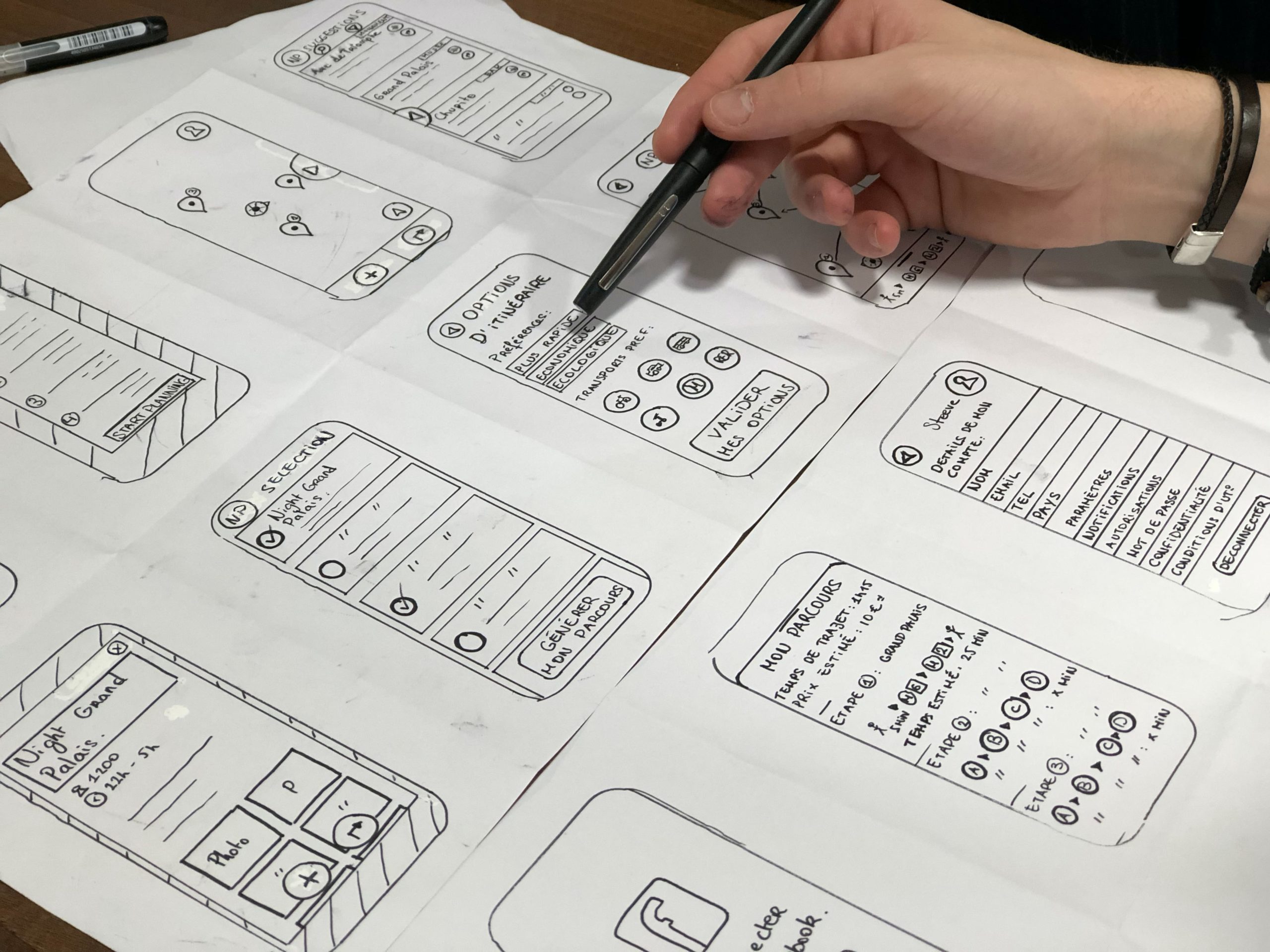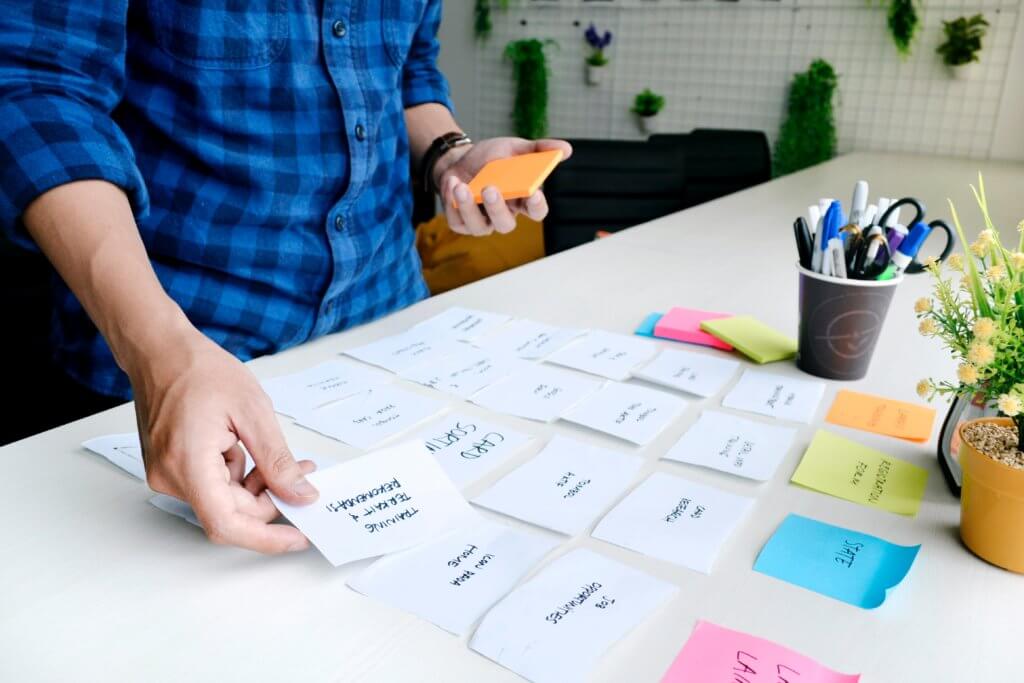Design
6
min read
Prototyping Tools: the best prototyping tools for UX Designers


Don't you want to read? Try listening to the article in audio mode 🎧
Ideation, design and prototyping are the preliminary stages necessary for the implementation of a UX ready for launch. But creating a prototype as faithful as possible to the final result you want to achieve is not always an easy task. For this reason, Designers have at their disposal the so-called Prototyping Tools, that is tools that integrate the must-have features, in order to make prototyping faster and more effective, thus, allowing industry professionals to optimize time and resources.
 One of the strengths of Figma is FigJam, which is an online whiteboard designed to simplify brainstorming through which to publish, share and consult annotations, charts, workshops and any other resource concerning the path from ideation to execution of a prototyping process.
Figma can be tested for free by subscribing to the “Starter” formula which allows you to use the service's plugins and templates, as well as manage an unlimited number of personal files and a maximum of 3 projects, regardless of the number of participants involved. There are also two paid plans ("Professional" and "Organization") geared precisely to the needs of professionals and businesses.
One of the strengths of Figma is FigJam, which is an online whiteboard designed to simplify brainstorming through which to publish, share and consult annotations, charts, workshops and any other resource concerning the path from ideation to execution of a prototyping process.
Figma can be tested for free by subscribing to the “Starter” formula which allows you to use the service's plugins and templates, as well as manage an unlimited number of personal files and a maximum of 3 projects, regardless of the number of participants involved. There are also two paid plans ("Professional" and "Organization") geared precisely to the needs of professionals and businesses.
 Hence you have the ability to track all components being implemented, as well as those that need review or have been approved. Integration with various collaborative development and cloud synchronization solutions such as Trello, Slack, Dropbox and JIRA is also supported.
Used by several large companies including LinkedIn, Twitter, Uber and Salesforce, it is available in a Web based version for prototyping intended for Internet, iOS and Android. It provides free use for the realization of a single project, while there are paid plans for the development of a greater number of projects.
Hence you have the ability to track all components being implemented, as well as those that need review or have been approved. Integration with various collaborative development and cloud synchronization solutions such as Trello, Slack, Dropbox and JIRA is also supported.
Used by several large companies including LinkedIn, Twitter, Uber and Salesforce, it is available in a Web based version for prototyping intended for Internet, iOS and Android. It provides free use for the realization of a single project, while there are paid plans for the development of a greater number of projects.
 It is a comprehensive solution available to those who want to create websites, Apps, graphics for brands and video games. All features provided enable it to face any prototype creation stages, from the creation of the wireframe to the distribution of resources to the developers.
As often happens with other products from the same parent company, this tool can also be used in combination with other Adobe products, including After Effects and Photoshop. You can test the features available through a 7-day free trial. Then, you can choose between two rate plans, one with only Adobe XD and a second one with over 20 Adobe Creative Cloud Apps.
It is a comprehensive solution available to those who want to create websites, Apps, graphics for brands and video games. All features provided enable it to face any prototype creation stages, from the creation of the wireframe to the distribution of resources to the developers.
As often happens with other products from the same parent company, this tool can also be used in combination with other Adobe products, including After Effects and Photoshop. You can test the features available through a 7-day free trial. Then, you can choose between two rate plans, one with only Adobe XD and a second one with over 20 Adobe Creative Cloud Apps.
 Unlike other Prototyping Tools, this is a solution designed specifically for the Apple ecosystem. It is based on Core Animation, an animation engine with support for hardware acceleration for macOS and iOS that allows the execution of multiple processes simultaneously, and includes several features typical of Macs, among them full-screen mode, Retina Interface and Auto Save.
Used in projects by the likes of Microsoft, Google, Netflix, Amazon, Apple, Nike and Starbucks, Principle can be purchased as standalone software in a version compatible with macOS 10.13 (High Sierra) or later. Its license key also allows you to access free updates for 12 months.
Unlike other Prototyping Tools, this is a solution designed specifically for the Apple ecosystem. It is based on Core Animation, an animation engine with support for hardware acceleration for macOS and iOS that allows the execution of multiple processes simultaneously, and includes several features typical of Macs, among them full-screen mode, Retina Interface and Auto Save.
Used in projects by the likes of Microsoft, Google, Netflix, Amazon, Apple, Nike and Starbucks, Principle can be purchased as standalone software in a version compatible with macOS 10.13 (High Sierra) or later. Its license key also allows you to access free updates for 12 months.
 People used to work with other tools for the implementation of UX found in Framer support for importing projects made using Sketch or Photoshop. It also comes with a system that allows you to see previews of any type of work on all possible target devices.
Equipped with capabilities for resource sharing within a team and advanced version control tools, Framer can be used free of charge by up to 2 editors and for no more than 3 projects with an unlimited number of views. There are also 2 paid versions (“Pro” and “Enterprise”) respectively for small work groups and companies with over 20 employees.
People used to work with other tools for the implementation of UX found in Framer support for importing projects made using Sketch or Photoshop. It also comes with a system that allows you to see previews of any type of work on all possible target devices.
Equipped with capabilities for resource sharing within a team and advanced version control tools, Framer can be used free of charge by up to 2 editors and for no more than 3 projects with an unlimited number of views. There are also 2 paid versions (“Pro” and “Enterprise”) respectively for small work groups and companies with over 20 employees.
 Used by companies such as Trainline, BlaBlaCar, Stripe and BuzzFeed, Marvel presents itself primarily as a collaborative tool in which to centralize all the resources that allow you to create a complete prototype, including feedback sent by collaborators and testers during the phases of design and pre-production verification.
The platform allows you to convert static mockups into interactive online prototypes in just 5 minutes and without having to write a single line of code. A free version is available that supports a single project for only one user plus a tester. The proposed "Pro", "Team" and "Enterprise" formulas are all paid and designed for individual professionals, small teams and large organizations.
Used by companies such as Trainline, BlaBlaCar, Stripe and BuzzFeed, Marvel presents itself primarily as a collaborative tool in which to centralize all the resources that allow you to create a complete prototype, including feedback sent by collaborators and testers during the phases of design and pre-production verification.
The platform allows you to convert static mockups into interactive online prototypes in just 5 minutes and without having to write a single line of code. A free version is available that supports a single project for only one user plus a tester. The proposed "Pro", "Team" and "Enterprise" formulas are all paid and designed for individual professionals, small teams and large organizations.
 All prototypes created with Protopie can be enhanced with interactive features without the need to write code, regardless of whether projects are being developed for smartphones, tablet PCs, smart TVs, the Internet or multiple platforms.
Used for prototyping in over 15,000 different companies including Google, Spotify, Samsung, Adidas, Toyota and Nintendo, Protopie can be tested through a free demo or used by subscribing to some rate plans dedicated to professionals and companies, as well as customizable subscription formulas designed for more structured companies.
All prototypes created with Protopie can be enhanced with interactive features without the need to write code, regardless of whether projects are being developed for smartphones, tablet PCs, smart TVs, the Internet or multiple platforms.
Used for prototyping in over 15,000 different companies including Google, Spotify, Samsung, Adidas, Toyota and Nintendo, Protopie can be tested through a free demo or used by subscribing to some rate plans dedicated to professionals and companies, as well as customizable subscription formulas designed for more structured companies.
Prototyping Software: what is it?
A Prototyping Software, or Prototyping Tool, is a platform that simplifies and speeds up the creation of a prototype of a product, and therefore of the product itself. It allows you to create realistic prototypes with which to demonstrate the effectiveness of the idea and design that made it possible to transform it into an "object" to be tested in the experimental stages prior to commercial distribution. In the case of UX, the creation of interactive prototypes with which customers can understand what the finished product will be, plays a very important role. For this reason, Prototyping Software often provides tools with which to program workflows, import resources from other applications, convert files into various formats, manage the progress of Design components, and create animations from static graphic content. A Prototyping Tool is first and foremost a solution designed for creatives. Therefore, it must be able to support the latter in all those steps that enable it to start from the initial concept of a UX to get to the first model (the prototype) of a finished product and ready for the deployment phase.Why to use a prototyping tool
When working on a UX design, the goal is to create a product that matches customers and end users’ expectations as much as possible, especially in terms of usability. To quickly achieve this result, it is necessary to have tools that allow not only to prototype a perfect UX to be presented during testing. In fact, you need to be able to propose more versions of the same prototype, in order to understand which is the most suitable for conversion into a product that best suits the reference market. These tools are precisely Prototyping Tools that allow you to simplify, and in some cases automate, much of the work required during the design, resource sharing, feedback and evaluation of the prototypes made phases.Prototyping Tools: which one to choose?
Once you understand the importance of prototyping tools in the work of UX Designers and developers, it is useful to ask what the criteria for choosing this particular type of tools should be. Wanting to provide some general guidelines, we can say that a Prototyping Tool must:- have, in turn, an intuitive user interface;
- allow you to work easily in a team;
- integrate features that allow you to quickly convert static content into interactive works;
- support integration with other platforms (applications for resource sharing, editing programs, to-do lists...);
- ensure compatibility with as many systems and devices as possible.
Figma
Figma is a Cloud-based platform that can be used directly from a web browser and it is available to developers and designers who wish to create UX prototypes in a collaborative environment. It is no coincidence that its slogan is “Nothing great is made alone”. One of the strengths of Figma is FigJam, which is an online whiteboard designed to simplify brainstorming through which to publish, share and consult annotations, charts, workshops and any other resource concerning the path from ideation to execution of a prototyping process.
Figma can be tested for free by subscribing to the “Starter” formula which allows you to use the service's plugins and templates, as well as manage an unlimited number of personal files and a maximum of 3 projects, regardless of the number of participants involved. There are also two paid plans ("Professional" and "Organization") geared precisely to the needs of professionals and businesses.
One of the strengths of Figma is FigJam, which is an online whiteboard designed to simplify brainstorming through which to publish, share and consult annotations, charts, workshops and any other resource concerning the path from ideation to execution of a prototyping process.
Figma can be tested for free by subscribing to the “Starter” formula which allows you to use the service's plugins and templates, as well as manage an unlimited number of personal files and a maximum of 3 projects, regardless of the number of participants involved. There are also two paid plans ("Professional" and "Organization") geared precisely to the needs of professionals and businesses.
InVision
InVision is a hugely popular Prototyping Tool that allows you to manage Design components within a workflow in which any element of a project can be added via Drag & Drop, by using a column layout, each of which is associated to a specific state of progress. Hence you have the ability to track all components being implemented, as well as those that need review or have been approved. Integration with various collaborative development and cloud synchronization solutions such as Trello, Slack, Dropbox and JIRA is also supported.
Used by several large companies including LinkedIn, Twitter, Uber and Salesforce, it is available in a Web based version for prototyping intended for Internet, iOS and Android. It provides free use for the realization of a single project, while there are paid plans for the development of a greater number of projects.
Hence you have the ability to track all components being implemented, as well as those that need review or have been approved. Integration with various collaborative development and cloud synchronization solutions such as Trello, Slack, Dropbox and JIRA is also supported.
Used by several large companies including LinkedIn, Twitter, Uber and Salesforce, it is available in a Web based version for prototyping intended for Internet, iOS and Android. It provides free use for the realization of a single project, while there are paid plans for the development of a greater number of projects.
Adobe XD
Adobe XD, formally Adobe Experience Design, is a platform compatible with Android, iOS, Windows and macOS that allows you to carry out UX prototyping procedures, no matter their destination, such as the Web or applications for operating systems. It is a comprehensive solution available to those who want to create websites, Apps, graphics for brands and video games. All features provided enable it to face any prototype creation stages, from the creation of the wireframe to the distribution of resources to the developers.
As often happens with other products from the same parent company, this tool can also be used in combination with other Adobe products, including After Effects and Photoshop. You can test the features available through a 7-day free trial. Then, you can choose between two rate plans, one with only Adobe XD and a second one with over 20 Adobe Creative Cloud Apps.
It is a comprehensive solution available to those who want to create websites, Apps, graphics for brands and video games. All features provided enable it to face any prototype creation stages, from the creation of the wireframe to the distribution of resources to the developers.
As often happens with other products from the same parent company, this tool can also be used in combination with other Adobe products, including After Effects and Photoshop. You can test the features available through a 7-day free trial. Then, you can choose between two rate plans, one with only Adobe XD and a second one with over 20 Adobe Creative Cloud Apps.
Principle
"Animate Your Ideas, Design Better App" is the slogan of a toolset with which it is possible to create complete prototypes, animations and interactive user interfaces. Principle allows you to design for the Web, mobile devices and the Desktop, producing realistic outputs. Unlike other Prototyping Tools, this is a solution designed specifically for the Apple ecosystem. It is based on Core Animation, an animation engine with support for hardware acceleration for macOS and iOS that allows the execution of multiple processes simultaneously, and includes several features typical of Macs, among them full-screen mode, Retina Interface and Auto Save.
Used in projects by the likes of Microsoft, Google, Netflix, Amazon, Apple, Nike and Starbucks, Principle can be purchased as standalone software in a version compatible with macOS 10.13 (High Sierra) or later. Its license key also allows you to access free updates for 12 months.
Unlike other Prototyping Tools, this is a solution designed specifically for the Apple ecosystem. It is based on Core Animation, an animation engine with support for hardware acceleration for macOS and iOS that allows the execution of multiple processes simultaneously, and includes several features typical of Macs, among them full-screen mode, Retina Interface and Auto Save.
Used in projects by the likes of Microsoft, Google, Netflix, Amazon, Apple, Nike and Starbucks, Principle can be purchased as standalone software in a version compatible with macOS 10.13 (High Sierra) or later. Its license key also allows you to access free updates for 12 months.
Framer
Framer is a Prototyping Software designed primarily for website developers who need to tackle all project phases from a single platform. For this reason, templates are available to adapt to your needs, and also ready-to-use components to be included in Web pages. People used to work with other tools for the implementation of UX found in Framer support for importing projects made using Sketch or Photoshop. It also comes with a system that allows you to see previews of any type of work on all possible target devices.
Equipped with capabilities for resource sharing within a team and advanced version control tools, Framer can be used free of charge by up to 2 editors and for no more than 3 projects with an unlimited number of views. There are also 2 paid versions (“Pro” and “Enterprise”) respectively for small work groups and companies with over 20 employees.
People used to work with other tools for the implementation of UX found in Framer support for importing projects made using Sketch or Photoshop. It also comes with a system that allows you to see previews of any type of work on all possible target devices.
Equipped with capabilities for resource sharing within a team and advanced version control tools, Framer can be used free of charge by up to 2 editors and for no more than 3 projects with an unlimited number of views. There are also 2 paid versions (“Pro” and “Enterprise”) respectively for small work groups and companies with over 20 employees.
Marvel
Designed specifically for rapid prototyping, Marvel is a tool that allows you to easily manage the workflow that, starting from a basic idea, enables you to create a digital product within a team, through the phases of experimentation and testing. Used by companies such as Trainline, BlaBlaCar, Stripe and BuzzFeed, Marvel presents itself primarily as a collaborative tool in which to centralize all the resources that allow you to create a complete prototype, including feedback sent by collaborators and testers during the phases of design and pre-production verification.
The platform allows you to convert static mockups into interactive online prototypes in just 5 minutes and without having to write a single line of code. A free version is available that supports a single project for only one user plus a tester. The proposed "Pro", "Team" and "Enterprise" formulas are all paid and designed for individual professionals, small teams and large organizations.
Used by companies such as Trainline, BlaBlaCar, Stripe and BuzzFeed, Marvel presents itself primarily as a collaborative tool in which to centralize all the resources that allow you to create a complete prototype, including feedback sent by collaborators and testers during the phases of design and pre-production verification.
The platform allows you to convert static mockups into interactive online prototypes in just 5 minutes and without having to write a single line of code. A free version is available that supports a single project for only one user plus a tester. The proposed "Pro", "Team" and "Enterprise" formulas are all paid and designed for individual professionals, small teams and large organizations.
Protopie
Protopie allows the creation of interactive and realistic prototypes which are very similar to what the finished digital product will be. It is in fact an advanced solution that can be used for prototypes of Internet sites, Web Applications, Mobile Apps, Desktop software and IoT systems. All prototypes created with Protopie can be enhanced with interactive features without the need to write code, regardless of whether projects are being developed for smartphones, tablet PCs, smart TVs, the Internet or multiple platforms.
Used for prototyping in over 15,000 different companies including Google, Spotify, Samsung, Adidas, Toyota and Nintendo, Protopie can be tested through a free demo or used by subscribing to some rate plans dedicated to professionals and companies, as well as customizable subscription formulas designed for more structured companies.
All prototypes created with Protopie can be enhanced with interactive features without the need to write code, regardless of whether projects are being developed for smartphones, tablet PCs, smart TVs, the Internet or multiple platforms.
Used for prototyping in over 15,000 different companies including Google, Spotify, Samsung, Adidas, Toyota and Nintendo, Protopie can be tested through a free demo or used by subscribing to some rate plans dedicated to professionals and companies, as well as customizable subscription formulas designed for more structured companies.
Conclusions
Prototyping Tools are solutions that make the work of UX Designers easier and allow you to create UX prototypes. However, not all software created for this purpose have features that really simplify and speed up professionals’ tasks. Therefore, it is essential to know which characteristics a Prototyping Tool should have, and the fundamental criteria by which to choose the best tool.
Article updated on: 09 August 2023

Don't Waste Your Talent. Turn It Into a Career With a Course That Fits Your Needs!
Talent Garden is your Digital Skills Academy, offering courses in Digital Marketing, UX Design, Digital HR and Data Analysis designed to launch your career.
Keep reading

2
min read
Fail Fast, Learn Faster: 4 Rapid Prototyping Techniques
Prototypes are not art; they are tools that enable you to test and experiment. Many companies are taking a new approach ...
Talent Garden
28/07/2021

3
min read
Roche: Pushing Innovation Through Prototyping
In the age of Digital Transformation, businesses need to adapt to sudden changes in the socioeconomic trends in order ...
Talent Garden
07/10/2020

4
min read
Innovation management: process, tools and trends
When you think of “innovation” your mind may immediately go to big inventions or to disruptive changes to an existing ...
Talent Garden
23/04/2021

9
min read
8 Best Project Management Software & Tools in 2020 for Effective Project Managers
Like every superhero, project managers need their own gadgets and tools. Thankfully, we have more at hand nowadays than ...
Talent Garden
08/09/2020
